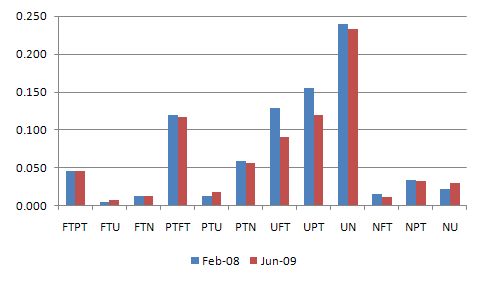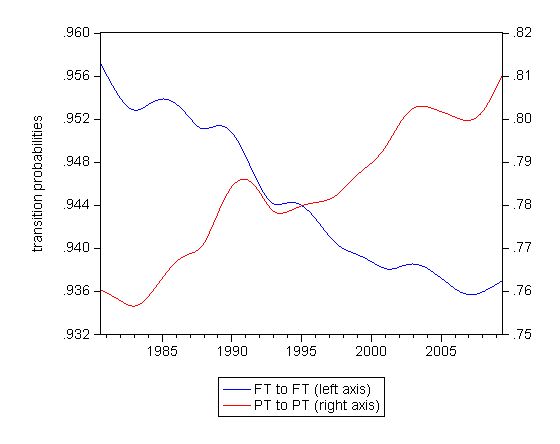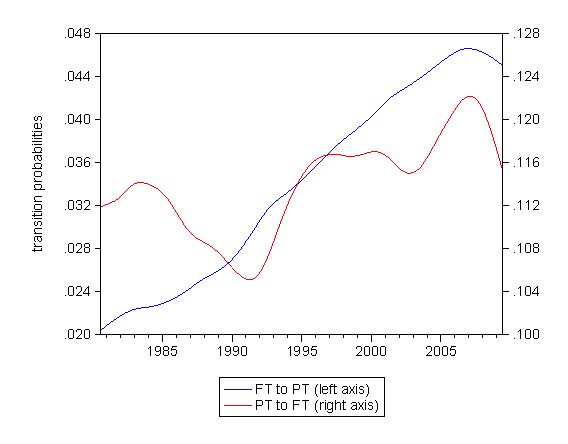I haven't provided detailed commentary on the US labour market for a while now. To…
More gross flows – movements between employment
Last Monday’s blog asked What can the gross flows tell us?. The topic is vast given the detail and in that blog I only considered the inflows and outflows from unemployment. In this blog I analyse the flows between full-time and part-time employment as well as movements between non-participation and employment to finish off the story. The analysis helps us understand what is happening during this downturn to
As a refresher, gross flows analysis allows us to trace flows of workers between different labour market states (full-time employment; part-time employment; unemployment; and non-participation) between months. So we can see the size of the flows in and out of the labour force more easily and into the respective labour force states (employment and unemployment).
The various inflows and outflows between the labour force categories are expressed by the ABS in 000s of persons. But a useful alternative presentation is to compute transition probabilities, which are the probabilities that transitions (changes of state) occur. For example, what is the probability that a person who is unemployed now will enter full-time employment next period.
So if a transition probability for the shift between full-time employment to unemployment is 0.05, we say that a worker who is currently employed full-time has a 5 per cent chance of becoming unemployed in the next month. If this probability fell to 0.01 then we would say that the labour market is improving (only a 1 per cent chance of making this transition).
The following table (reproduced from last Monday’s blog) shows the schematic way in which gross flows data is arranged each month – sometimes called a Gross Flows Matrix. Here FT refers to full-time employment, PT to part-time employment, U to unemployment and N to not-in-the-labour force. The subscripts t and t-1 refer to the current month and the previous month, respectively.
For example, the element FT to FT tells you how many people who were in full-time employment in the previous month (t-1) are in full-time employment in the current month (t). Similarly the element FT to U tells you how many people who were in full-time employment in the previous month (t-1) are now unemployed in the current month (t). And so on. This allows you to trace all inflows and outflows from a given state during the month in question.
The transition probabilities are computed by dividing the flow element in the matrix by the initial state. For example, if you want the probability of a worker remaining unemployed between the two months you would divide the flow (U to U) by the initial stock of unemployment, Ut-1. If you wanted to compute the probability that a worker would make the transition from full-time employment to unemployment you would divide the flow (FT to U) by the initial stock of full-time employment, FTt-1. And so on. So for the 4 states we can compute 16 transition probabilities reflecting the inflows and outflows from each of the combinations.
The first graph shows you what is happening to the transition probabilities since the labour market turned down in February 2008 (the low-point unemployment rate month in the last cycle). It shows that the FTU probability (full-time employment to unemployment) and the PTU (part-time employment to unemployment) have both risen somewhat reflecting the increased likelihood that employed workers will lose their jobs. FTU rose from 0.005 (February 2008) to 0.007 (June 2009) while the PTU rose from 0.013 (February 2008) to 0.017 (June 2009). Part-time workers have a much higher probability of losing their job than full-time workers and that disadvantage is rising.
The FTPT transition probability – that is, the likelihood that a fully-employed worker will become part-time employed (which might tell us something about the so-called “labour hoarding” that is alleged to be going on) has actually fallen from 0.46 (February 2008) to 0.45 (June 2009). So this information does not fit with that conjecture. If firms were busily rationing full-time workers’ hours and converting their jobs into part-time positions then I would have expected to have seen that transition probability rise.
The PTFT (part-time to full employment) transition probability has fallen from 0.120 (February 2008) to 0.117 (June 2009) which conforms with the view that firms have reduced their full-time recruitment.
Interestingly, at the top of the boom (February 2008) an unemployed person had more chance of getting a full-time job (0.129 per cent) than a part-time worker (0.12 per cent). While more analysis is needed this result does not provide much comfort for the neo-liberals who have always claimed it was better to get the unemployed into “burger flipping” as a path to full-time work than to provide adequate welfare support to the unemployed. The UFT probability has fallen over the downturn to 0.09 per cent (June 2009) so as the ranks of the unemployed swell, there is less chance than previously of securing a full-time job.
The UPT transition probability has fallen from 0.155 (February 2008) to 0.12 (June 2009) as the downturn has evolved. It remains true that it is easier for unemployed workers to enter employment via part-time work than full-time despite the downturn.
The exits between participation and non-participation are also interesting. The transition probability FTN (full-time employment to non-participation) has remained constant (0.12) while the PTN probability has fallen slightly from 0.58 (February 2008) to 0.56 (June 2009). The inflows from non-participation to employment suggest that NFT transition probability (non-participation to full-time employment) has fallen significantly from 0.014 (February 2008) to 0.011 (June 2009) and the NPT probability has fallen from 0.034 (February 2008) to 0.033 (June 2009). So it is less likely that new entrants or re-entrants to the labour force will get work now. The transition probability between NU (non-participation to unemployment) has risen from 0.022 (February 2008) to 0.029 (June 2009) meaning that non-participants are now more likely to enter the labour force as unemployed than at the height of the boom. The UN (unemployment to non-participation) transition probability has fallen from 0.24 (February 2008) to 0.234 (June 2009) which reinforces the current view that the “added worker” effect is outweighing the “discouraged worker” effect. This is a typical pattern in the early stages of a drawn out downturn – see my blog The labour market is getting sicker for more analysis of this.
Transitions between full-time and part-time employment
The following graph shows the employment inertia transition probabilities (FT to FT; and PT to PT), that is, the probability that you will remain in your current employed state. The results are very stark and tell you the story of how the Australian labour market has been transformed into one that increasingly provides precarious work at the expense of full-time work. If you match this with the fact that underemployment has risen dramatically since the 1990s, you realise that the boom cycle we have just left was not one that generated high quality employment.
It is interesting that the inertia has risen during the current downturn – workers are less willing to experiment with changing their labour market states. In the 1991 recession we do not see this happening. So this is a research question that needs further investigation.
The next graph shows the intra-employment transition probabilities (FT to PT; and PT to FT). You can see that over the last 30 odd years the chances of a full-time worker becoming part-time employed has steadily risen and accelerated during the 1991 recession. In the current downturn this has sharply fallen. Again this is not consistent with the “labour hoarding” argument which says that firms are not sacking workers but converting them into part-timers. The FTPT probability has fallen sharply in the last couple of years. This is partly as the labour market tightened (and the trend towards increasing part-time work stalled temporarily) but even in recent months since the downturn the decline has continued.
Further, the PT to FT transition probabilities fell sharply during the Hawke years (which really started the rot in the labour market) and in recent years rose sharply (noting my previous point about the impact of the tightening labour market up to February 2008). During the course of the downturn the chance that a part-time worker will find full-time employment has plummeted. That is consistent with a increasingly slack labour market where mobility between part-time and full-time employment is dramatically in decline.
What about a comparison between the 1991 and 2009 recessions? I traced the flow probabilities FTPT, FTN and PTFT and PTN from November 1989 (the low-point unemployment rate for that cycle) and February 2008 (the recent low-point unemployment rate). The 1991 recession saw the unemployment rate peak in December 1992 whereas the current downturn is not yet exhausted. The horizontal axis is the months since the low-point unemployment rate. The graphs are not very interesting yet so I won’t publish them.
Digression: Tomorrow: ACTU Jobs Summit – Pathways to Recovery
I am giving a presentation tomorrow at the ACTU Jobs Summit – Pathways to Recovery, which is on between 10.00 and 16:00 at the Auditorium, Unions NSW, 4 Goulburn Street, Sydney.
The advertising material says:
The summit aims to address the impact of Global Financial Crisis on working Australians and their families. It will involve leading academics from around Australia on the issues of employment and recovery for working Australians, generating jobs in Australia, and the quality of work. There will be opportunities for discussion and debate from union and community groups attending the summit.
My panel is about Generating Jobs in Australia and is Session 2, 13:00 to 14.30.
There are lots of interesting speakers and topics. The event is open to the public and free although they did want you to register for catering purposes – you can find information about that HERE if you are interested.
I will provide a report on Tuesday probably.
Digression: Tour de France
Big night tonight! We don’t even know if Lance has it in the hills yet. Contador surely has (given his push up to Arcalis the other day). I am hoping it comes down to a realistic showdown on Mont Ventoux (one of my favourite climbs) on Saturday.
You might be interested in these retrospectives. It was in the days when I raced a lot in Europe and had good contact with Lance:




Who did you race with in Europe Bill?
i’ve done a little kermese racing in Belgium, but should probably retire now due to lack of motivation and general fatness!